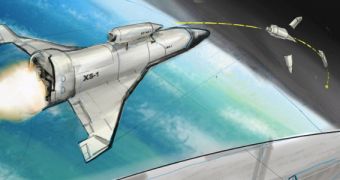Official document released by the United States Defense Department reveal that the Defense Advanced Research Projects Agency (DARPA) will receive $130 million (€94 million) in extra funding from 2015 to 2018 for developing the Experimental Spaceplane (XS-1) program. Originally, the project got $670 million (€485 million) in funding, but current levels are at $800 million (€580 million).
This amount is allotted for all space programs currently under development at DARPA, but it is very likely that the lion's share will go to the XS-1 initiative. The purpose of this program is to design and develop a fully reusable, unmanned spacecraft capable of providing access to space and low-Earth orbit just like an aircraft would.
DARPA wants a clean and simple design for XS-1, which would enable the space plane to fly routinely, sometimes more than once per day. The spacecraft will also be able to take off from a wide range of locations around the world, something that no other vehicle in its class can boast of. This asset could also be used as a platform for testing next-generation space and hypersonic flight technologies.
Officials with the DARPA Space Programs and Technology Office only requested $180 million (€130.5 million) for fiscal year 2015, which is only $7,5 million (€5.5 million) over last year's funding levels. For FY2015, the XS-1 program asked for $27 million (€19.6 million), as opposed to $10 million (€7.25 million) in FY 2014, Space News reports.
The overarching goal of the XS-1 is to enable private and government entities to boost cargoes into low-Earth orbit 10 times in 10 days, at an average cost of less than $5 million (€3.6 million) per flight. This is a far cry from the 60 to 70 million dollars (€43.5 to 51 million) SpaceX charges for launching its Falcon 9 medium-lift delivery system. This is the cheapest available rocket launch option out there.
“The long-term intent is for XS-1 technologies to be transitioned to support not only next-generation launch for Government and commercial customers, but also global reach hypersonic and space access aircraft,” the Agency said in a statement released in November 2013.
“Technologies derived from the XS-1 program will enable routine space launch capabilities with aircraft-like cost, operability and reliability,” the same announcement explained. Handling this type of high-risk, high-payoff technology development projects is precisely why DARPA was created.
The Agency has also requested $55 million (€40 million) for the Airborne Launch Assist Space Access (ALASA) program, which involves developing and launching low-weight satellites for a maximum of $1 million (€720,000) apiece. FY2014 funding level for this project was $42 million (€30 million).
DARPA also announces that the main contractor for the XS-1 project will most likely be selected in 2015. The program should then reach the final design and development stage within 2 to 3 years, with a maiden flight tentatively scheduled for 2018.

 14 DAY TRIAL //
14 DAY TRIAL //